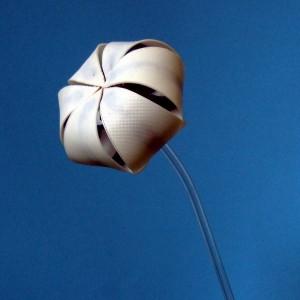Before you get too excited, let me tell you that this is not an article about how to create yourself as a young Arnold Schwarzenegger through 3D printing… for now, we must all remain the shape we are. Instead, the muscles that I’m talking about are flexible 3D printed petals powered by air.
This idea, beautiful in both its conception and its execution, is brought to us via Instructables contributor Mikey77 who has been sharing his knowledge through the site since 2007. His posts have received a great deal of attention and just a brief walk through his past contributions makes it easy to see why. I was sufficiently intrigued to follow him over to his website and I strongly recommend that you do as well. There, you will be treated to information about his work over the last 25 years including a robot so small it can fit on a dime and yet has wheels and a gripper, robot art, and articles about conductive fabrics.
The Instructable provided is for the creation of a flower with six 3D printed petals that can open and close. This is no gimmick, however; there are some significant possibilities for application as the type of air activated muscle becomes more and more refined. Mikey77 foresees applications in soft robots that would make them more friendly to the human hand. I can also imagine things such as light shades, heart valves, and a number of other applications that would transfer this biomimicry to an increasing nu
“Flower muscles are the smallest volume of muscle that can produce a large amount of movement,” Mikey77 notes on the Instructables page. “They could be used as indicators of pressure, temperature, or other parameters. They can also be used to latch moving pieces or to open and close protective enclosures. Controlled as separate petals, they could be used to indicate numbers. They could also be used to create facial expressions on a robot head.”
Mikey77 has previously released designs for artificial muscles, but the methods he used previously were for silicone casting, which he admits did not have the same possibilities for precision as there is in 3D printing. For this particular project, he used Ninjaflex, a flexible filament to print the muscles on a MakerBot Replicator2. However, because of the nature of the 3D printing process, a mesh of tiny holes that make it impossible for the muscle to respond to air pressure and so after printing, he dipped them in flexible elastomeric glue.
Using this same technique, he has created a zig-zag pullmuscle capable of lifting more than four pounds and only occupying 2.5 cubic inches when fully expanded. Mikey77 provides the STL files and step-by-step instructions to walk you through the creation of your own muscular flower. He used Autodesk’s free software program 123D Design to render the model.
He explained his vision of the future of robotics:
“[I]f it is to become more affordable and useful, [it] will involve the 3D printing of soft robot muscles and skin teamed up with 3D printed stiff bones and shells. This will minimize the number of expensive servos and gear-motors that will be necessary. It should eventually be possible to print the muscles, bones, and skin of a robot in one print.”
Do you agree with Mikey77’s vision? Let us know your thoughts on his design and potential applications of this robotic technology in the 3D Printed Muscles forum thread at 3DPB.com.
